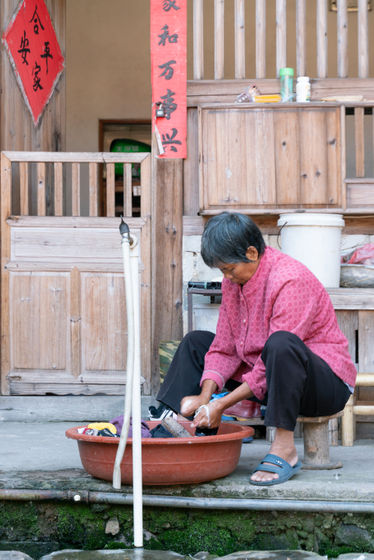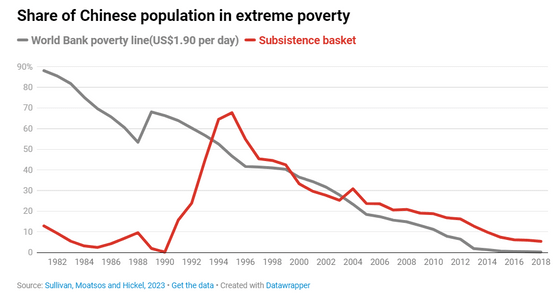China's 'capitalist reforms' are believed to have lifted 800 million people out of extreme poverty, but data shows the opposite

by
From the 1980s to the 1990s, China implemented reform and opening up to transform its economy from communism to capitalism. The view among many economists is that this eradicated extreme poverty from China, but a paper has been published that points out that in fact it has created a large number of low-income people suffering from poverty.
Full article: Capitalist reforms and extreme poverty in China: unprecedented progress or income deflation?
https://www.tandfonline.com/doi/full/10.1080/13563467.2023.2217087
China's capitalist reforms are said to have moved 800 million out of extreme poverty – new data suggests the opposite
https://theconversation.com/chinas-capitalist-reforms-are-said-to-have-moved-800-million-out-of-extreme-poverty-new-data-suggests-the-opposite-216621
According to a report by the World Bank, in the 40 years since 1980, the number of people in China with an income of less than $1.9 (about 280 yen) per day has decreased by 770 million. As a result, China's extreme poverty rate went from 88% in 1981, the highest in the world, to virtually zero in 2018.
In this report, the World Bank cited comments from a senior Chinese official praising China's fight against poverty, which has benefited more people than any other country in human history. It is said to be a role model.

However, some economists are skeptical of this view. According to Dylan Sullivan, a part-time fellow at Macquarie University in Australia, the World Bank's calculations use an indicator called
Purchasing power parity is a standard method used to compare the purchasing power of ordinary people between countries, including the famous Big Mac index . However, a growing body of literature criticizes this method, saying that it does not take into account purchasing power for the minimum services and goods necessary for survival, and therefore has limitations as an indicator for estimating poverty alleviation.
In a paper published in the peer-reviewed academic journal New Political Economy, Sullivan et al. calculate the extreme poverty rate in China based on data released by the Organization for Economic Co-operation and Development (OECD). We valued our income against the cost of meeting our needs. The ``minimum necessities for life'' used in the analysis ranged from daily calories, essential nutrients, the cost of 3 square meters of housing, clothing, heating equipment, and soap prices.

The study found that between 1981 and 1990, at the end of the socialist era, China's extreme poverty rate averaged just 5.6%, one of the lowest in the developing world. Compared to developing countries of similar size, India's rate was 51%, Indonesia's rate was 36.5%, and Brazil's rate was 25.9%.
However, China's poverty rate increased dramatically after market reforms, reaching a peak of 67.7% in 1995. This is thought to be because food and housing costs have soared due to the relaxation of price regulations, putting pressure on low-income households.
Below is a graph comparing China's extremely poor population (red line) calculated by Mr. Sullivan et al. with the World Bank's poverty line (black line). Contrary to the commonly held theory, China's poverty rate was low from around 1980 to 1990, when calculated based on the prices of food, clothing, and shelter necessary for survival, while it was I found out that it was very high.

Although China's economy has quadrupled since 1990, the poverty rate in 2018 remained at about the same level as between 1981 and 1990, which the World Bank calculated was 'virtually zero.' This has not yet been achieved.
Researchers believe that China's previous low poverty rate was due to socialist policies controlling the prices of food and housing. In addition to prices, many social indicators such as average life expectancy, infant mortality rate, average years of schooling, and the percentage of the population with access to electricity support Sullivan et al.'s speculations.
From this point of view, the research team concluded, ``While China's remarkable industrial development has greatly improved access to modern appliances, information technology, and other goods, It is clear that many people in China are suffering in the transition to a market economy.Industrial development is important, but at least in the context of capitalist reform and social policy retrenchment, ``growth alone is not enough.'' 'This is an important finding because it suggests that extreme poverty cannot be reduced.'
Related Posts:
in Note, Posted by log1l_ks







